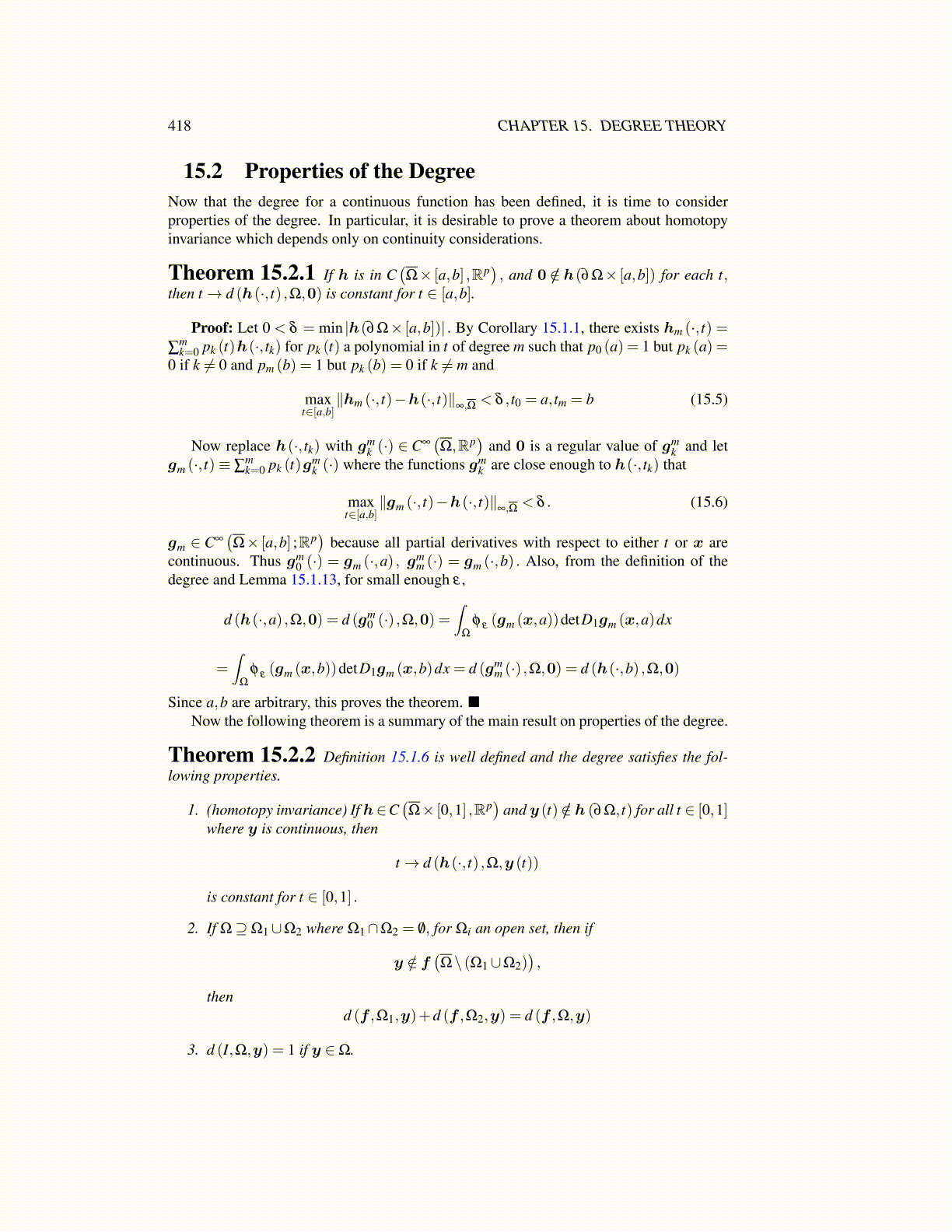
418 CHAPTER 15. DEGREE THEORY
15.2 Properties of the DegreeNow that the degree for a continuous function has been defined, it is time to considerproperties of the degree. In particular, it is desirable to prove a theorem about homotopyinvariance which depends only on continuity considerations.
Theorem 15.2.1 If h is in C(Ω× [a,b] ,Rp
), and 0 /∈ h(∂Ω× [a,b]) for each t,
then t→ d (h(·, t) ,Ω,0) is constant for t ∈ [a,b].
Proof: Let 0 < δ = min |h(∂Ω× [a,b])| . By Corollary 15.1.1, there exists hm (·, t) =∑
mk=0 pk (t)h(·, tk) for pk (t) a polynomial in t of degree m such that p0 (a) = 1 but pk (a) =
0 if k ̸= 0 and pm (b) = 1 but pk (b) = 0 if k ̸= m and
maxt∈[a,b]
∥hm (·, t)−h(·, t)∥∞,Ω < δ , t0 = a, tm = b (15.5)
Now replace h(·, tk) with gmk (·) ∈ C∞
(Ω,Rp
)and 0 is a regular value of gm
k and letgm (·, t)≡ ∑
mk=0 pk (t)gm
k (·) where the functions gmk are close enough to h(·, tk) that
maxt∈[a,b]
∥gm (·, t)−h(·, t)∥∞,Ω < δ . (15.6)
gm ∈ C∞(Ω× [a,b] ;Rp
)because all partial derivatives with respect to either t or x are
continuous. Thus gm0 (·) = gm (·,a) , gm
m (·) = gm (·,b) . Also, from the definition of thedegree and Lemma 15.1.13, for small enough ε ,
d (h(·,a) ,Ω,0) = d (gm0 (·) ,Ω,0) =
∫Ω
φ ε (gm (x,a))detD1gm (x,a)dx
=∫
Ω
φ ε (gm (x,b))detD1gm (x,b)dx = d (gmm (·) ,Ω,0) = d (h(·,b) ,Ω,0)
Since a,b are arbitrary, this proves the theorem. ■Now the following theorem is a summary of the main result on properties of the degree.
Theorem 15.2.2 Definition 15.1.6 is well defined and the degree satisfies the fol-lowing properties.
1. (homotopy invariance) If h∈C(Ω× [0,1] ,Rp
)and y (t) /∈ h (∂Ω, t) for all t ∈ [0,1]
where y is continuous, then
t→ d (h(·, t) ,Ω,y (t))
is constant for t ∈ [0,1] .
2. If Ω⊇Ω1∪Ω2 where Ω1∩Ω2 = /0, for Ωi an open set, then if
y /∈ f(Ω\ (Ω1∪Ω2)
),
thend (f ,Ω1,y)+d (f ,Ω2,y) = d (f ,Ω,y)
3. d (I,Ω,y) = 1 if y ∈Ω.